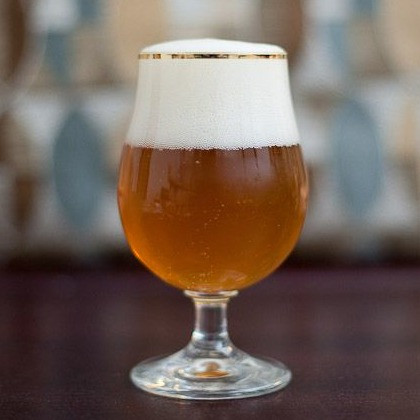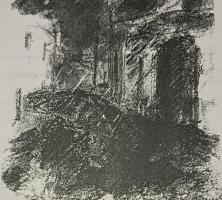Copy Link
Add to Bookmark
Report
HOMEBREW Digest #0969

This file received at Sierra.Stanford.EDU 92/09/15 00:33:15
HOMEBREW Digest #969 Tue 15 September 1992
FORUM ON BEER, HOMEBREWING, AND RELATED ISSUES
Rob Gardner, Digest Coordinator
Contents:
SG, Baderbrau, Bottles (Jack Schmidling)
Oops--spoke too soon! (Phillip Seitz)
Liberty clone (Frank Tutzauer)
Stout to Porter Alchemy (7226 Lacroix)
lagering temps (Dave Suurballe)
Re-using CO2 (David Taylor RMIT Bundoora)
Question on yeast ... ("C. Lyons")
hard cider query (Shaun Vecera)
Is a Grain Mill Necessary? (919) 541-7340" <FP$JEFF@RCC.RTI.ORG>
water chemistry question (Charlie Hamilton)
Visit to Rochester, NY (BOB JONES)
Belgium Malt (George J Fix)
Briess malt for ales (jim busch)
Racking during primary fermaentation (card)
CANNING JAR SAFETY VENTS! (card)
More on Hop Bines (Thomas P. Rush)
1056 and Slow Fermentation ("John Cotterill")
Homebrew Digest #968 (September (Koehler)
DMS rebutts from Micah Millspaw (BOB JONES)
Price of Corona Mills (Kinney Baughman)
RE: Sinking hops (Paul dArmond)
Send articles for __publication__ to homebrew@hpfcmi.fc.hp.com
(Articles are published in the order they are received.)
Send UNSUBSCRIBE and all other requests, ie, address change, etc.,
to homebrew-request@hpfcmi.fc.hp.com
Archives are available via anonymous ftp from sierra.stanford.edu.
(Those without ftp access may retrieve files via mail from
listserv@sierra.stanford.edu. Send HELP as the body of a
message to that address to receive listserver instructions.)
**Please do not send me requests for back issues!**
*********(They will be silenty discarded!)*********
**For Cat's Meow information, send mail to lutzen@novell.physics.umr.edu**
----------------------------------------------------------------------
Date: Fri, 11 Sep 92 23:09 CDT
From: arf@ddsw1.mcs.com (Jack Schmidling)
Subject: SG, Baderbrau, Bottles
To: Homebrew Digest
Fm: Jack Schmidling
>From: polstra!larryba@uunet.UU.NET (Larry Barello)
>With regard to adjusting the SG for temperature. Why not play it
safe and always read at the calibration temperature? I use a tall
drinking glass filled with ice and water.....
I can not conceive of dropping a hydrometer in boiling or even hot wort but I
guess people do it. It just seems intuitive that it would explode.
Your method certainly is the scientific way to do it but I doubt that anyone
can read or trust the cheapo hombrew hydrometer to within 2 points and that
is the difference between 60 and 80F. So cooling in tap water is my lazy
man's alternative and good enough for practical purposes.
>From: bryan@tekgen.bv.tek.com
>Subject: Baderbrau Pilsner
>A little over a year ago at the Oregon Brew Festival, I had a pilsner which
I believe was made by Baderbrau. It seems like the guy who started it/brewmaster
had worked for a major brewery in the US, but was from Czechoslovakia.
He is just a good salesman. Born in the US and visited there several times.
>Can anyone tell me what style of a beer this is?
I wouldn't begin to tread on such hallowed ground without the proper
credentials.
>What beer from a major brewery would approximiate it?
ARF Generic Lager, of course.
>Anyone have any all-grain recipies for a beer like this one?
This is my synthesis of their recipe from conversations with the owner during
the shooting of my video.
12 lbs pale malt (they use Briess)
1 lb caramel malt (source unknown)
3 oz SAAZ hops
lager yeast
"Firebrew", vigorous rolling boil.
Ferment and age at 45F for 35 days.
>This is really reaching, but does anyone know what the OG, SG, bittering
units and type of hops used for bittering and finishing are?
The only hops used is imported Saaz. Gravity, BU's and ratio of crystal to
pale malt, he would not reveal. Actually, he didn't even know but when I
pressed him to find out, he declined.
The numbers in my recipe are just a guess but the ingredients and lagering
temp/time are correct.
He claims adherence to Reinheigtsgbot and that absolutely nothing else is
added.
..........
The following was posted to usenet and I thought I would share it with the
Digest....
> csci180b@cl2.cl.uh.edu (Bill Fay) writes:
>1) How much care should I give in sterilizing my bottles while bottling?
>I've tried the standard bleach solution but its kind of a pain finding a
>place to soak 50+ bottles at one time.
Let me lay out a procedure that has always worked well for me.
Rig up a short length of plastic hose to your water tap with the usual
adapter readily available at any hardware store. The length of the hose
should reach only to about one inch above the bottom of your sink.
Line up some clean bottles on the sink.
Fill the first one with bleach and stick a funnel into the next one and pour
the bleach from the first into this one.
Set the empty one in the bottom of the sink and poke the hose into this and
run the tap.
Pour the bleach from number two into number three and stick the hose into
number two.
Pour the water out of number one and it is ready to fill. Everytime you fill
one, you move the others down the line.
The process is continuous and you only sanitize what you need, as you need
them. The straight bleach requires almost no resting time to do its job and
the sanitized bottles are exposed to the air for the bare minimum.
Try it, you may like it.
js
------------------------------
Date: Sat, 12 Sep 92 13:41 GMT
From: Phillip Seitz <0004531571@mcimail.com>
Subject: Oops--spoke too soon!
The debate on Wyeast Belgian has been going on for some weeks, and
just yesterday I sent in a comment suggesting that all this banana
stuff might be a bit exaggerated. This was based on the two
brews I've made with it, the second of which was sitting at home
while I wrote the message, waiting to be bottled.
Well, unbeknownst to me, at the same time as I was writing the
message, someone broke into our house, chloroformed the dog, and
(*gasp!*) put a banana in my beer.
So far at least the taste and smell are discernable but not
overwhelming, and since it was meant to be a Belgian beer in
the first place the flavor doesn't seem that weird (I'm sure
my Belgian friends wouldn't object). On the other hand, I
certainly wouldn't want ALL my Belgian beers to taste that way.
So, I will eat crow and offer apologies to all. In memory of
the event, I have even re-named the beer. Anyone want a glass
of Bananabrau?
------------------------------
Date: 13 Sep 1992 12:54:55 -0400 (EDT)
From: Frank Tutzauer <COMFRANK@ubvmsb.cc.buffalo.edu>
Subject: Liberty clone
About six months ago, someone asked for a Liberty Ale clone.
Rick Larson responded with an all-grain recipe for "Taking
Liberty Ale," based on Quentin Smith's Zymurgy winner. I took
Rick's recipe and came up with this extract version:
Taken Liberties Ale
1/2 lb. crystal malt, 60L
1 c English 2-row pale malt
7 lbs. light Munton and Fison dried malt extract
1/2 oz. Galena pellets (alpha = 12.0; 60 minutes)
1/2 oz. Irish Moss (15 minutes)
1 oz. Cascades pellets (alpha = 5.5; 12 minutes)
Wyeast American Ale 1056 (dregs of secondary, previous batch)
1 oz Cascades pellets (alpha = 5.5; dry hop)
1/2 c. corn sugar for priming (with a keg; more if bottles)
Cracked grains and steeped in 2 (U.S.) quarts 150-155F water for
45 minutes. Collected runoff and sparged with an additional 1
and 1/2 gallons 170F water. Added to brew kettle with enough
additional water to make 5 and 1/2 gallons. Dissolved extract
and boiled 65 minutes, adding hops and Irish Moss as shown.
Chilled with an immersion chiller down to 70F. Racked off break
and pitched onto dregs of the secondary of a previous batch, a la
Father Barleywine. Active fermentation in under 12 hours. O.G.
= 1.056; IBU = approximately 33 (not counting the dry hopping
which would have added a point or two). Single-stage blowoff
fermentation in the low 70's. Primary was 4 days, after which I
attached a fermentation lock and dumped in the dry-hopping hops.
After another 19 days of secondary, I racked to a Cornelius keg
primed with 1/2 c. of corn sugar. After waiting a week or so, I
tapped, keeping 20 psi on the keg at all other times. (Keg
stored at room temp, dispensed through a jockey box.)
Comments: Two weeks after priming, I did a side-by-side with a
bottle of Liberty Ale. The beers were of a similar clarity and
hue, although Liberty Ale is slightly lighter in color. Liberty
is also more aggressively carbonated, but the heads are similar.
Liberty Ale is slightly more bitter, but, paradoxically, it also
has a slightly maltier taste. (Incidentally, my Anchor Steam
clone has the same difference in malt taste. I use M&F for it,
too.) The cascade aroma of the two beers is similar, but Liberty
Ale has a more pronounced Cascade flavor, and definitely a more
pronounced Cascade aftertaste. My beer is smoother and has more
body. The brews are similar enough that if you served mine to
someone who was expecting Liberty Ale, they probably would not be
able to tell the difference, although a side-by-side comparison
would reveal the imposter. Next time, I'm going to decrease the
lovibond of the crystal a little bit (to get a lighter color),
and also use a _little_ more Cascades for finishing and dry
hopping (say on the order of a quarter ounce).
------------------------------
Date: Sun, 13 Sep 92 10:43:15 MDT
From: stevel@chs.com (7226 Lacroix)
Subject: Stout to Porter Alchemy
The other week, I decided to try one of the Cat's Meow recipes. I was
trying the Mackeson Clone, with a few changes...therein lay the problem.
After a Woody Allenesque episode (no, not that) with a yeast starter the
night before, everything went rather smoothly during the boil. I added
a pound of rolled oats on the front of the recipe (steeped until the H2O
boiled, then removed) and didn't really notice anything odd about the
wort until I racked it into the primary. Then, almost right before my
very eyes, the oddest protein formations started to form in the carboy!
I left about 3/4 inch of trub in the brewkettle so I was somewhat surprised
when this occurred. The wort was about 77F going into the carboy, but wow!
After a couple of hours there were "sludge seperations" at various levels
in the carboy seperated by layers of clear wort. Any way, after
fermentation started, and about a gallon of liquid blewout of the tube/bottle
it settled down (all in less than 24 hours). As the vigorous fermentation
stopped, a fair amount of sludge (1 inch) began to settle at the bottom of
the carboy. I racked into a secondary and found the sludge to be sort of
a gelatinous (probably the oats) substance and yeast bodies. Almost
immediately after the "Stout" (now a mere 3.5 gallons of its former self..
I started with a 5 gallon batch) stopped fermenting and yeasties dropped
to the bottom of the secondary. By the time I bottled, leaving another inch
of sludge in the bottom of the secondary, I ended up with about 3 gallons!
Interestingly enough, the "Stout" tasted more like a nice Porter...not so
strange but certainly unexpected. So, to answer some questions before
posing my own...1) The oats were not boiled, but were "Quick Oats" 2) The
Secondary was VERY clean and sterile (read borderline anal on this point)
3)Wort was cooled with an immersion chiller prior to racking into the
primary 4)I underused the black patent by 1# 5)It's still in the bottle, my
sample came during bottling, so I don't have a final final result. Now the
questions...1) Where did all of those "protein" formations come from?
(Answers like "From God" will be silently disregarded) 2)Since the
fermentation was so vigorous could it complete itself in 24 or so hours?
3) Would fermentation at say 65 degrees limited the blowoff volume (I
fermented it at about 70-75F)? 4) When using oats, can I expect to lose so
much in the first racking to the "sludge factor"?
I realize that I've omitted some of the facts, and that this note
rambles a little, and I'm not panicky about the whole thing, but damn has
this thing piqued my curiosity?? (above reference to cinamatic genius...
see "Sleeper"...kitchen scene) Comments????
------------------------------
Date: Sun, 13 Sep 92 16:59:47 PDT
From: Dave Suurballe <suurb@dumbcat.sf.ca.us>
Subject: lagering temps
After 205 ales, I've decided to brew my first lager, and yesterday
I bought a packet of Wyeast Munich #2308. I have no idea what
temperatures to ferment and lager at. Would those of you who have
experience with this yeast please send me some advice? Thanks.
Suurb
suurb@dumbcat.sf.ca.us
------------------------------
Date: 14 Sep 1992 17:14 -0500 (EST)
From: David Taylor RMIT Bundoora <DAVID@phillip.edu.au>
Subject: Re-using CO2
Gooday!
Re: collecting and re-using CO2
I recently met a fellow homebrewer, Alan, (via a mutual aquaintance) who
has been brewing for some time in relative isolation as he lives in a
country town.
He's been grain brewing for some time and has become quite accomplished,
brewing large batches and dispensing from kegs. One advantage he has is
that he is close to a northern Victorian hop farming district and knows
some of the growers.
I told him about HBD and discussed the many gems of HBD lore and net-
wisdom! Alan has been working on getting his conditioning gas levels
right for various styles and has tried to develop a relationship between
beer volume, gas pressure and temperature. Recalling discussion on HBD
I searched the archive and FTP'd the CO2 tables. I sent them to him
along with CM2, 6 weeks of HBD's various collected notes and recipes.
Alan was pleased to put it mildly!
I was impressed when Alan told me that he has been experimenting with
re-using CO2 given off during fermentation, just like the big brewers!
Transport costs force up the price of CO2 refills where he lives, so he
started by collecting the gas in another keg attached by blowoff tube.
Alan then runs a small 12V diaphragm car tyre pump to raise the pressure
into a cylinder. Details are sketchy.
The collected gas has been used to successfully condition beer and to
push it around. I asked Alan whether he had equipment to dry (or filter)
the gas before compressing it but he said he hadn't addressed that issue
as yet.
Alan and I would be interested in any comments netbrewers may have on
re-using CO2?
Cheers... David
------------------------------
Date: Mon, 14 Sep 92 08:24 EDT
From: "C. Lyons" <LYONS@adc1.adc.ray.com>
Subject: Question on yeast ...
I've brewed several batches of beer recently with Whitbread and
Vierka yeast (4 batches each). I believe I see a definite
difference. All batches with the Whitbread yeast had gentle
fermentations with a relatively thin Kraeusen lasting
approxiamately two days. In a 6.5 gallon carboy no blow-off
setup is needed, as the kraeusen doesn't rise high enough to
warrent it. However, for the Vierka yeast the primary
fermentation was much more violent, with a blow-off setup
recommended (or, since I didn't bother, plenty of rags to pick up
the overflow). The primary fermentation with Vierka lasts 3
days, 1 day longer than with Whitbread. Some additional
specifics include: all brews are of the pale ale style, most
were extracts (although a partial mash and an all-grain behaved
the same), all were fermented at 65F (basement temp.), and all
worts were quickly cooled to 60F before pitching yeast. After 8
batches, I'm convinced that the difference is with the yeasts.
These two yeasts act considerably different. I am concerned with
the final alcohol content of my beers. Would a yeast such as
Vierka, which results in high kraeusen give a higher alcohol
content, or does the kraeusen have any bearing on the actual
fermentation? Is it possible that the Whitbread is doing an
equivalent job of fermenting in a shorter period with a thinner
kraeusen? What characteristics do people look for in their
yeasts (i.e. what is desirable?). I'm very confused and concerned
(but not worried YET), and would appreciate any comments on what
type of yeast activity is preferable (and why).
... Christopher Lyons
lyons@adc1.adc.ray.com
------------------------------
Date: Mon, 14 Sep 1992 08:38:56 -0400 (EDT)
From: Shaun Vecera <sv11+@andrew.cmu.edu>
Subject: hard cider query
Any good (and relatively easy) hard cider recipes out there? Any
responses will be appreciated!
Shaun
*********************************************
Shaun P. Vecera
Department of Psychology
Carnegie Mellon University
Pittsburgh, PA 15213-3890
email: vecera@cmu.edu
sv11+@andrew.cmu.edu
*********************************************
------------------------------
Date: 14 Sep 1992 08:53:49 -0400 (EDT)
From: "Jeff McCartney (919) 541-7340" <FP$JEFF@RCC.RTI.ORG>
Subject: Is a Grain Mill Necessary?
>>>
>>>---------------------------
>>>
>>> Date: Fri, 11 Sep 92 09:51:16 PDT
>>> From: gak@wrs.com (Richard Stueven)
>>> Subject: Why Should I Buy a Grain Mill?
>>>
>>> I picked up twenty pounds of pale malt yesterday, and while I was
>>> waiting for them to grind it and bag it, I noticed a Corona mill for
>>> sale for $60. At first I thought, "that's not a whole lot of money",
>>> but then I tried to figure out how cost-effective it really is.
>>>
>>> I buy grains twenty or forty pounds at a time, for $0.64 per pound.
>>> For an extra $0.04 per pound, they grind the grain for me. So to get
>>> that Corona mill to pay for itself, it would take 1500 pounds of grain;
>>> three-quarters of a ton! At about eight pounds per batch, that's about
>>> 187 batches of beer, and at roughly thirty batches per year, I'm
>>> looking at over six years for a $60 investment to pay off. That
>>> doesn't strike me as very good economics.
>>>
>>> ...... My question is: am I
>>> getting a good deal as it is, or am I overlooking something that would
>>> convince me to buy a grain mill?
I'm still an extract brewer but my grain brewing friends purchase their
grain from brewpubs ALREADY CRACKED. Most U.S. brewpubs buy their grain
ALREADY CRACKED! The reason is simple- most brewpubs are relatively small and
if they cracked their own grain in a brewing or food area, flour would make a
MESS of the place! And you can bet that the 100# bags of grain the brewpubs
get are cracked CORRECTLY for the specific type of grain.
------------------------------
Date: Mon, 14 Sep 92 10:06:59 EDT
From: hamilton@roadrunner.pictel.com (Charlie Hamilton)
Subject: water chemistry question
Hi gang,
I have a question about water chemistry. I called my town's water
department to request info on the mineral & ion content, etc. of my
water. They gave me the amounts in milligrams/liter. I want to
compare them against the recommended numbers in Dave Miller's
book. The only problem is that Miller measures in units of ppm.
Is there an easy way of converting from mg/l to ppm, or do I have
to figure out the molecular weight of each ion and compare it to
the number of H20 molecules in a liter. If I have to do that I
won't. I'm not even sure its worth it at all, because my town
gets water from 5 different sources, and the guy claims that these
numbers are correct for all of them. He can't be right, because I
used to live on the other side of town, and the water there is brown,
and my water is now clear.
Has Nybody taken their water to a lab to get the mineral/ion content?
If so, how much does it cost.
Thanks,
Charlie (hamilton@pictel.com)
------------------------------
Date: Mon, 14 Sep 1992 07:08 PDT
From: BOB JONES <BJONES@NOVAX.llnl.gov>
Subject: Visit to Rochester, NY
I'll be on business travel next week, and would like to know of places I
shouldn't miss while in Rochester, NY. Are there any good brew pubs there?
Thanks in advance for any help.
Bob
------------------------------
Date: Mon, 14 Sep 92 09:23:06 CDT
From: gjfix@utamat.uta.edu (George J Fix)
Subject: Belgium Malt
I want to thank Tony Babinec for his excellent post in HBD #968. The data
he supplied is going to be very useful.
In our book, Laurie and I expressed the wish that "... color malt problem
may simply go away ..." with the malts Siebels was about to import from
Belgium. It has indeed gone away, and emerged again in a different form;
namely, with all the sensational color malts available which ones should we
use? We selected the Cara-Vienna and Cara-Munich in our Vienna since this
was the closest to our original recipe. We have been hearing some really
good things about the Munich, Aromatic, Caramel-Pils, and Special B. We plan
to try these for various beer styles in the future as well. Boy, there is a lot
of brewing that needs to be done!
The Biscuit malt is the most unusual malt I have ever seen. Has anyone brewed
with it? I personally would love to hear about other people's experiences with
it. I bet someone could create an entirely new beer style with this malt.
George Fix
------------------------------
Date: Mon, 14 Sep 92 10:28:01 EDT
From: jim busch <busch@daacdev1.stx.com>
Subject: Briess malt for ales
About the recent thread on Briess malt: I think most of us who
have used different malts realize that Briess is not the highest
quality malt available, it is what it is, cheap. That said, I
repeat my claim that good ALES can be made using this malt. I
am not as convinced about quality lagers created with this malt,
although several breweries do (as noted previously, Old Dominion
and Adler Brau). I am convinced that the beer quality from
these breweries would get even better if a higher quality malt
was used.
I think the consensus here is that for consistent high quality
lager beer, Briess is probably the worst choice. I am now
switching back to Froedterts malt since my supplier and price
have returned. I am also going to try out this Belgium malt,
since for homebrewers cost shouldnt be a big issue.
Jim Busch
------------------------------
Date: Mon, 14 Sep 92 10:45:52 EDT
From: card@apollo.hp.com
Subject: Racking during primary fermaentation
In Miller's new book, for certain top fermenting yeasts Wyeasts,
such as 1007 he recommends racking off the krausen, just as the head
starts to recede. He claims that if the yeast is allowed to fall back
into solution, the beer will take months to clear?
If I remember correctly, Miller was always against the blow-off method
claiming it to be wasteful, as well as possible source of contamination,
caused by back-ups. Sounds like his new,(?) racking at high krausen method,
is a lot riskier then blow-off tubes.
Any thoughts?
/Mal Card
------------------------------
Date: Mon, 14 Sep 92 11:29:58 EDT
From: card@apollo.hp.com
Subject: CANNING JAR SAFETY VENTS!
re: yeast starters
>> note: Miller "specifies" pint bottles but I've found if you use 1 quart
>> bottles, you can add the yeast directly into the bottle since there is now
>> adequate head room. This has worked successfully for me for about 6 batches
>> but I'd be interested to hear if anyone has had problems with this.
>> IE. exploding bottles.
>>
>> IN ANY CASE, ONCE THE YEAST HAS BEEN ADDED, CARE SHOULD BE TAKEN, AND IF THE
>> LID SWELLS, SIMPLY RELEASE THE PRESSURE WITH A QUARTER TURN OF THE COVER AND
>> RETIGHTEN.
A recent batch of very active wyeast 1028, actually deformed (buckled)
the canning lid about 12 hrs after I added to my starter. I feel lucky
it didn't explode.
I liken the deformed lid to a safety valve in electrolytic capacitors
that prevents the can from exploding. A portion of the pre-formed top
simply opens releasing the pressure.
From now on I'll use the conventional air-lock method. BTW, Miller
advocates sterile cotton balls jammed into the air-lock, instead of
liquid, for yeast starters. This allows one to swirl and oxygenate
the starter without liquid from the air lock dripping into solution.
I tried it after the my dented lid incident. Seemed to work great.
/Mal Card
------------------------------
Date: Mon, 14 Sep 92 12:27:35 -0400
From: trush@mhc.mtholyoke.edu (Thomas P. Rush)
Subject: More on Hop Bines
I also had the same experience as Paul, while picking Centennial
I had a prickly, burning sensation on my arms and face. It happened
on only one day and didn't reoccur picking Centennial again or any
other variety. This was one of the reasons I thought I may have had
an allergic reaction to the resins. I now think it may be due to
picking on a hot,humid day where the skin moisture may trigger a
reaction to the loose resin. Ever notice old photos of hand pickers
dressed in long sleeved shirts?
Also, I agree about rough handling of the cones can cause excessive
powder loss. When a hop cone is pulled off the bine instead of
snipped off with my thumbnail I notice a small shower of fine
powder. Incorrect picking could aggrivate the deposit of powder
on the picker(s).
Regarding follow-up questions on the Japanese Beatle problem--
you're correct Russ, J.B.'s do avoid the Cascades. Generally,
they prefer all the "noble" varieties(real class) this includes
all the Hallertauers. This is followed by the English aromatics.
They are particularly fond of Perle(German of English parentage?),
Liberty, and Goldings.
They're out there now a-munching and a-mating...a-munching and
a-mating... I can understand why they a so detested. Not only
am I giving them a free lunch, they shamelessly flaunt their
sexual prowess of dual mind control.
Keep a-brewing and a-pouring,
Tom Rush
------------------------------
Date: Mon, 14 Sep 92 10:02:59 PDT
From: "John Cotterill" <johnc@hprpcd.rose.hp.com>
Subject: 1056 and Slow Fermentation
Full-Name: "John Cotterill"
I currently have a batch of IPA in the primary. I am using 1056 yeast and the
starting gravity of the brew was about 1.060. The fermentation took off like
gangbusters to about 1.040. Now it is creeping along at 1 SG per 3 days or so.
It seems that whenever I use 1056 yeast in higher gravity beers, the
fermentation really slows down after the first few days of fermentation. Has
anyone else ever noticed this?
John
johnc@hprpcd.rose.hp.com
------------------------------
Date: Monday, 14 September 1992 2:01pm CT
From: Koehler@utxvm.cc.utexas.edu
Subject: Homebrew Digest #968 (September
Please take me off your mailing list. I don't know how I got on in the
first place. The e-mail addresses you might have for me are:
Koehler@utxvm.cc.utexas.edu and jay@psych.stanford.edu
Thanks.
- J. Koehler
------------------------------
Date: Mon, 14 Sep 1992 12:03 PDT
From: BOB JONES <BJONES@NOVAX.llnl.gov>
Subject: DMS rebutts from Micah Millspaw
Micah rebutts about DMS
>DMS gets produced from its precursors when the wort is above 140F. It's
>true that different malts have more or less of these precursors,
The sulfer content of the barley malt can be greatly effected during the
malt process. So I say its the malt.
>as Jim suggested, technique can also be a big factor. During a vigorous
>boil, the DMS gets boiled off, so a non-vigorous boil can increase your
>DMS levels.
Not only do utilize a vigorous and long boil (I've a 375,000 btu blaster)
but I have a forced draft on the kettle as well. If this set up can't
evaporate normal DMS I don't know what can. So I say its the malt.
> When the heat is turned off, is when most of the DMS that
>remains in your beer gets produced. Cooling quickly with a wort chiller
>to below 140F is the best way to minimize DMS production during this
>stage of the process.
The is more or less true.
>I'm sure that Micah uses a chiller,
>so the only factor I can guess, if Micah's boils are vigorous, is tapwater
>temperature. Perhaps Micah's tapwater is warm and an ice-bath pre-chiller
>would help cool the wort quickly enough to keep DMS below sensory thresholds?
I live in the sierra foothills and my tap water is in the summer 50F max.
Also this is the same wort chiller that I have been useing for the last
few years and no problems there. I say its the malt.
Also, this happened to others in my club who bought malt from this same lot
we each got several 50# sacks. So I say that its the malt.
Micah Millspaw
9/11/92
------------------------------
Date: Mon, 14 Sep 1992 16:58 EDT
From: Kinney Baughman <BAUGHMANKR@CONRAD.APPSTATE.EDU>
Subject: Price of Corona Mills
Richard Stueven writes:
>Subject: Why Should I Buy a Grain Mill?
>I picked up twenty pounds of pale malt yesterday, and while I was
>waiting for them to grind it and bag it, I noticed a Corona mill for
>sale for $60. At first I thought, "that's not a whole lot of money",
>but then I tried to figure out how cost-effective it really is.
I doubt this does much to the rest of your argument about cost-effectiveness
but Alternative Beverage in Charlotte (1-800-265-2739) sells Corona Mills
for $41.95. That might get you down to having to buy, say, only 1000 pounds
of grain before you get a return on your money. :-)
Cheers!
___ ----------------------------------------------------------- ___
| | Kinney Baughman | |
| | baughmankr@conrad.appstate.edu | |
\ / \ /
| "Beer is my business and I'm late for work" |
---------------------------------------------------------------
------------------------------
Date: Mon, 14 Sep 1992 13:49:57 -0700 (PDT)
From: Paul dArmond <paulf@henson.cc.wwu.edu>
Subject: RE: Sinking hops
If you have much fermentation going on, it can take a lot of weight to
sink hops. My friend Perry [the notorious Rev. Perry 10X Mills]
frequently dry hops in his open fermentor. For a ten gallon batch he will
use 2 - 4 oz of hops in a cheesecloth bag. He started out using a rock the
size of a large egg. It floated! Now he uses a rock the size of a baking
potato[e]. That keeps the herbs down with Davy Jones...
Marbles sound like a good idea, but it will take a lot. I know Perry's
rock won't fit through the neck of a carboy. Myself, I use pellets and
shake the carboy every once in a while. The pellet duff will sink
eventually, but it doesn't stick to the bottom.
Lastly, using a bag may slow down the diffusion into the beer, so
loose leaf vs. pellets vs. bagged leaf may all give different results with
similar amounts.
Yo ho ho. Make them hops walk the plank, matey! -- Paul
------------------------------
End of HOMEBREW Digest #969, 09/15/92
*************************************
-------


























